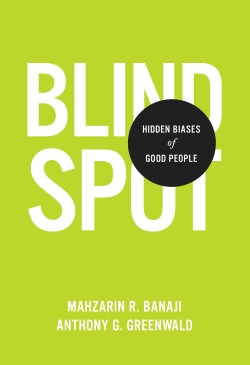Take Five: Tips for Uncovering Bias
Embrace diversity by becoming more aware of how the brain makes judgments

Mahzarin Banaji, a Harvard professor who studies bias, once adamantly refused to talk a persistent reporter - until the reporter told her she was an alum of Banaji's college.
"I heard that, and the words 'come on over, I'll talk to you' suddenly came out of my mouth," Banaji said. "All my rational reasons for not talking to her went out the window because we shared a zip code for four years."
Banaji, author of "Blindspot: Hidden Biases of Good People," shared that recollection when she visited Duke in February to present a workshop on how unconscious or hidden biases bias can affect efforts to promote a culture of diversity.
Research shows that we use different parts of our brains to deal with those who are more similar to us and those who are different. We internalize stereotypes. We judge trustworthiness within microseconds of meeting people based on little more than facial features. The outcome? These unconscious biases shape judgments about character, abilities and potential.
Banaji's visit was co-sponsored by the Office of the President and the Office for Institutional Equity as part of Duke's ongoing commitment to advancing an institutional culture of equity and diversity.
"Even people deeply committed to diversity and consciously striving to do the right thing are sometimes subtly influenced by their backgrounds, their experiences and the way their brains work," said Benjamin Reese, Jr., vice president of Duke's Office for Institutional Equity and chief diversity officer. "It's the work of a lifetime to counteract these biases."
Here are five tips, based on Banaji's work, to help uncover unconscious bias:
Acknowledge potential for bias. Learning about and accepting the brain's tendency toward bias is the first step in recognizing and dealing with it. Reese has used research by Banaji and others to create an eight-minute video for Duke community members to help identify when and how bias may affect the workplace. "The fact that our brains create bias is nothing to feel guilty about," Reese said. "But to truly embrace diversity, it is important to regularly check to see if these biases are influencing our decisions."

Learn about stereotypes. Heightened awareness of common stereotypes such as "women are good communicators" or "someone named Mohammed must be Muslim" can cue you in to whether stereotypes are influencing decisions, Reese said. He once gently challenged a search committee to reconsider its initial expectation that the best candidates would come from only a handful of particular schools. "Look closely at your expectations to see if they are colored by stereotypes," Reese said.
Broaden your focus. The human brain has an amazing capacity to screen out distractions. Imagine trying to drive if you paid attention to every billboard and sign. However, fixating on one idea or looking for a particular pattern in a set of data may blind you to other equally important data. "We tend to see what we expect to see, and when the data disagree, we often assume the data is wrong or ignore it," Banaji said.
Expose yourself to alien experiences. Exposing ourselves to different experiences changes the unfamiliar into the familiar. Banaji does this by having photographs on her screensaver jolt her into recognizing her own cultural assumptions. Her favorite is a picture of a construction worker wearing a hardhat and heavy boots while breastfeeding a baby on a lunch break.
"Not all bias is bad, but it is very humbling to realize you have biases you wish you didn't have," Banaji said. "It is important to recognize that a preference for diversity is not always a natural taste. It has to be acquired."